INTRODUCTION
The past decade has seen a remarkable upsurge of advancement and innovation in the health sector through the development of biomaterials [1,2]. With the increase in knowledge and understanding of the human body, biomaterials emerged with the ability to modify their properties to meet certain criteria and complement specific characteristics of the body, in contrast to previous materials having limited applications in the fields of aeronautics, electronics, and mechanical engineering [3,4]. The materials being exploited to innovate biomaterials immensely include metals and alloys, natural and artificial polymers, ceramics (silica and inorganic mixtures), and hybrid biomaterials [5,6]. For instance, Figure 1 shows the global market of various biomaterials and depicts the abundance of growth opportunities in the global biomaterial and biomedical market based on material types and biomedical applications, respectively. The contribution of biomaterials is considered to be major in the orthodontics field, with the need for improved stents, valves, or grafts, especially for cardiovascular disease treatments [7–9].
The fabrication and utilization of biomaterials for biomedical applications include the invention of new biomaterials that resemble many body tissues (bones, tendons, skin, ligaments, teeth, and so on) [10,11]. For the material to be considered in the synthesis process, whether alone or in combination with biomolecules or synthetic materials, the following criteria ought to be met: (i) Biocompatibility. (ii) Enhancing diffusion of metabolites/nutrients within cell or tissue. (iii) Prevention of reactive species. (iv) Avoid deleterious health effects. (v) Exhibiting stable chemical and biological plasma stability. (vi) Showing good bio-resorption or biodegradation kinetics. (vii) Promote in vivo characterization or compatibility [12]. Another rapid growth has been witnessed in hybrid biomaterials, which are an amalgam of different biomaterials with improved biocompatibility [13]. Such a characteristic enables them to mimic body tissues effectively and, in turn, prove their tremendous use in biomedical applications. For instance, the current success in treating bone defects requires hard tissue repair using metallic or ceramic biomaterials, which are biologically inert and possess resorbable capabilities [14]. Along with treating bone defects, biomaterials have various uses, including early detection and capture of tumor cells in blood samples and diagnosis and prognosis of many common diseases [15].
Biodegradable materials made of natural, synthetic polymers and hydrolyzable metals are indispensable components of implantable medical devices as they help generate a host immune response and are safely absorbed by the body after performing their function. These biodegradable devices eliminate the need for the removal of the device via secondary surgery and hence help avoid possible prolonged health perils associated with permanent devices [16]. Additionally, biomaterials have been found useful in tissue regeneration as scaffolds, helping to deliver cells, stimulate endogenic cells, furnish biological signals, and physically support the repair of tissues [17]. Biopolymers display characteristics that include regulating local angiogenesis and modulating the immune response to heal wounds [18]. Another area of biomedical applications whereby biomaterials have been found to be of enormous usefulness is in cornea repair and dental fixation issues. Biomaterial scaffolds are used to enhance cellular function and tissue production. The enormous use of biomedical materials is clearly reflected by the idea of having a total of 50,392 patents with the keyword “biomedical” being granted in the past decade.
BIOMEDICAL APPLICATIONS OF BIOMATERIALS
Orthopedic applications
Considerable improvements that have taken place in the orthopedic field over the last decade include the services of hybrid biomaterials. For instance, calcium phosphate (CaP)/collagen composite prepared using a porous CaP ceramic (porosity 60%–95%) as the substrate and I-type collagen (concentration 5–20 mg/ml) as the toughening/reinforcing phase under vacuum negative pressure (0–10Pa) at normal temperature exhibit good biocompatibility, mechanical strength, and biological activity [19]. Additionally, bone repairing material was prepared using 60%–75% of bioactive glass (particle size of 212–425 μm), 25%–40% of PEG (polyethylene glycol), and 0%–15% of hydroxyapatite (particle size of 50–200 nm) display good stability, biocompatibility, and safety [20]. Another composite bone repair material invented using a porous block-shaped ceramic scaffold and a stabilizing polymer facilitates bone defect repair and selective regeneration of natural bone along with good resistance to mechanical stresses [21].
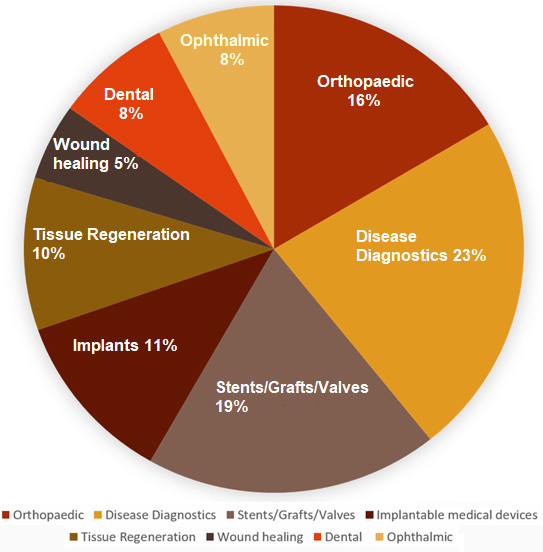 | Figure 1. Global market share of biomaterials. [Click here to view] |
An injectable liquid metal bone cement has been proven effective in treating osteoporosis; a bone tumor for such cement has high curing speed, low solidification temperature, simple preparation process, and stable structures in in-vitro and in-vivo environments with an X-ray self-developing function [22]. Nevertheless, an improved bone formation device was found to be more stable [23]. Likewise, a malleable bone graft consisting of keratin, osteoconductive ceramic-based filler, and antibiotic was capable of self-assembling into fibrous microstructures, which in turn implicates better osteoconductive properties [24]. Poly-(diol citrates)-based (POC)/Hydroxyapatite (HA) composite material has good function as bone screws whereby it has shown improved mechanical properties of bending, compression, shear, tension, and torsion [25]. Hybrid intramedullary rods (intramedullary nails or bone nails), patented in 2019, are convenient implantable medical devices for orthopedic applications like fracture stabilization and fixation [26]. Figure 2 shows the biomaterials action in bone fracture. However, a modified intramedullary device, which can expand at one or both ends with the shaft of the device also expanding if required, performs as a finer apparatus for fracture repair [27].
Bio-ceramics have played a significant role in the development of novelties for bone applications. Ceramics’ porous body patent proved to be a good osteogenesis material [28]. Comic meat comprising artificial bone is excellent in quantity securement, shape following, shock resistance, and sanitary confirmation [29]. Another improved artificial bone used for sustained drug release along with implantation applications can be molded into various bone-shaped sizes according to the bone defect [30]. The note-worthy novel patents using bio-metals for bone applications include a composite device invented by Monagham and Hoeman that combines porous metal and bone stimuli and promotes bone regeneration and resorption [31]. The biomaterial patents for orthopedic applications are tabulated in Table 1.
Applications in diagnosis of diseases
Another widespread use of biomaterials, and specifically that of hybrid biomaterials, is found in the treatment of diseases and disorders. For instance, a matrix composed of a naturally occurring protein backbone cross-linked by a synthetic polymer is considered useful in treating a disorder caused by tissue damage. Moreover, the polymer linked to the denatured fibrinogen releases a therapeutic portion of the fibrinogen in a pharmacokinetically regulated manner and thus helps treat the disorder [32]. Hybrid devices invented, consisting of naturally occurring polymers (collagen) and artificial ceramics (glass, hydroxyapatite, and so on), are used to boost the body’s self-healing mechanism, which provides rapid healing of musculoskeletal injuries and degenerative diseases [33].
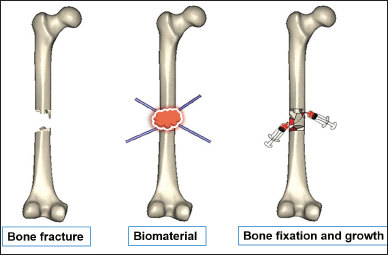 | Figure 2. Biomaterial patents illustrating the applications in bone fracture. [Click here to view] |
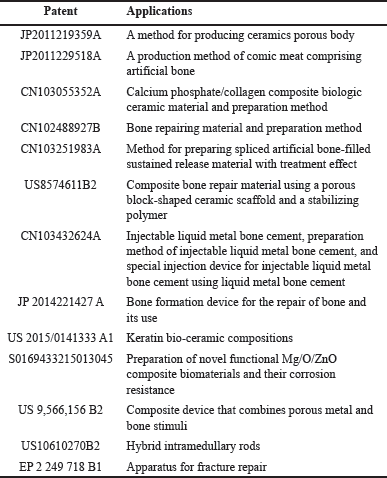 | Table 1. Biomaterial patents for orthopaedical applications. [Click here to view] |
Hyaluronic acid-gold nanoparticles/protein complex, which is used to treat liver diseases, displays properties of stability, biocompatibility, biodegradability, and liver tissue-specific delivery [34]. Another dual-purpose thermos-sensitive poly (organophosphate)-superparamagnetic nanoparticle complex is considered suitable for the detection and treatment of cancer hyperthermia [35]. Also, the administration of PEGylated cysteine variants of IL–11 in the body stimulates platelet production and accelerates patient recovery from thrombocytopenia [36]. A composition containing biocompatible hydrogel encapsulating mammalian cells and anti-inflammatory drugs was proven effective in reducing fibrotic over-growth for at least 10 days after implantation [37]. Recent inventions using hybrid biomaterials include antibodies in combination with N-glycoside-linked sugar chains lacking fucosylation, which was found to be helpful in the diagnosis of many diseases. Moreover, the use of SBA-15 ceramics adsorbs antibiotics like vancomycin, linezolid, and rifampicin and can be used in the treatment of osteomyelitis [38].
With bio-metals and biopolymers being enormously utilized, it is evident to mention how interferon-b, which is delivered to the body with the help of aggregating metal (iron, copper, nickel, molybdenum, and tungsten) of concentration less than 500 parts per billion is used to treat multiple sclerosis [39]. A group in China invented a magnetosome formulation with transition metal formulation and chains extracted from magnetotactic bacteria for a similar magnetic irradiation antitumor therapy. Another application devised is the curcumin-conjugated nanoparticles made up of superparamagnetic iron oxide for noninvasive early detection of Alzheimer’s plaques [40]. Similarly, an invention made use of gold nanoparticles or gold particles alone and was found to promote neurite outgrowth, hence treating and preventing neurological disorders [41]. Nitric oxide-releasing biodegradable polymers derived from 1,4 oxazepan 7-one and its derivatives have been verified useful for in situ-controlled delivery of additional bioactive agents and for treating various medical conditions (restenosis, aneurysms, and vulnerable plaque) [42]. Another invention demonstrated the use of intracellular stimuli-sensitive chitosan-graft-metformin prodrug in Type 2 diabetes combination therapy with improved lipid profile reversed the insulin resistance in obese mice and improved the fatty liver phenotype without toxicity [43]. Compositions comprising both hydrophobic and hydrophilic polymers have been shown to treat skin diseases and disorders. Certain naturally occurring and synthetic zwitter ionic polymers have been found to induce T regulatory (Treg) cells and exert immunosuppressive effects both in vitro and in vivo, which in turn help treat asthma and allergies. Potassium-binding polymers were used to treat ion imbalances like hyperkalemia [44]. Recent innovations using biopolymers include a biodegradable cationic polymer derived from the first cyclic carbonyl monomer (produced by ring-opening polymerization). These polymers have low cytotoxicity and are capable of forming complexes with biologically active materials, making them helpful in gene therapeutics and drug delivery [45]. Cyclodextran-based polymers were also invented recently, and once conjugated with therapeutic agents, they help treat autoimmune, inflammatory, central nervous system, and cardiovascular diseases [46]. Figure 3 shows the biomaterial used in various organs. The biomaterial patents for diagnostic applications are tabulated in Table 2.
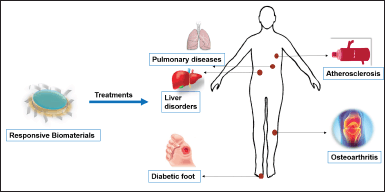 | Figure 3. Biomaterial patents illustrate the applications in the treatment of various diseases. [Click here to view] |
Applications such as stents, grafts, implants
Biomaterials have been extensively used for the fabrication of stents, grafts, and implants for a long time now, yet their use has massively increased over the past decade. A hybrid material of an anti-bacterial surface that can controllably release anti-microbial peptides was used for surgical implantation [47]. An injectable, moldable, tunable composite comprising of a thermosetting polymer, a ceramic-based bone-substitute/ bone-derived material (allo-, auto-, or xenograft origin), optional plasticizer (for more pliability), and therapeutic compounds were capable of becoming complex personalized bone grafts [48]. Bio erodible metal (Mg)/ceramic (HAp) stent made of a composite with uniform HA nanoparticles has enhanced strength, lower erosion rate, and promoted resorption [49]. A nanofiber-based electrospun composite material comprising fibroin was found viable as a heart valve replacement [50]. Recent patents include an implantable therapeutic delivery system made of a substrate, an inner polymeric coating surrounding the substrate, and an outer hydrogel coating with therapeutic agents, which are being tested for the treatment of type 1 diabetes [51].
A CaP-based ceramic with a selected dopant for manufacturing resorbable scaffolds shows controlled strength loss, ensuring long-term healing from surgeries such as spinal grafts [52]. Magnesium-based biodegradable biomaterials are particularly helpful as stents in the blood vessels of the body, whereby their formulation is based on the ability to achieve the desired mechanical characteristics while avoiding any toxic or undesirable side effects in the body [53]. Coatings that controllably release metal ions to create an anti-microbial zone and could be fine-tuned to enhance the galvanic release of the anodic metal are considered very versatile as they could be made into implants, patches, scaffolds, and strands [54]. An implant material comprising homogeneously distributed fluorescent nanodiamonds in a matrix of magnesium or a magnesium alloy shows increasing strength of the healing bone [55]. An improved form of this invention was designed recently, in which the stent has an additional coating of anti-inflammatory/anti-proliferative active agent [56]. Side-chain crystallizable polymers were designed as stents and are helpful in partially occluding a body cavity [57]. Stents comprising of biocompatible copolymers or homopolymers of 4-hydroxybutyrate and optionally poly-L-lactic acid and other additives are flexible, resistant to recoil and creep, and could be expanded and found applicable in coronary and urological diseases [58]. Bioactive composite made of thermoplastic polyaryletherketone and combeite (bio-glass) showed enhanced mechanical properties with better bioactivity as compared to conventional screws [59]. An artificial heart valve invented recently includes a multiplicity of synthetic polymeric leaflets that help optimize the functionality of the heart valves during the life of the patient [60]. Table 3 summarizes biomaterial patents for stents/grafts/implant applications.
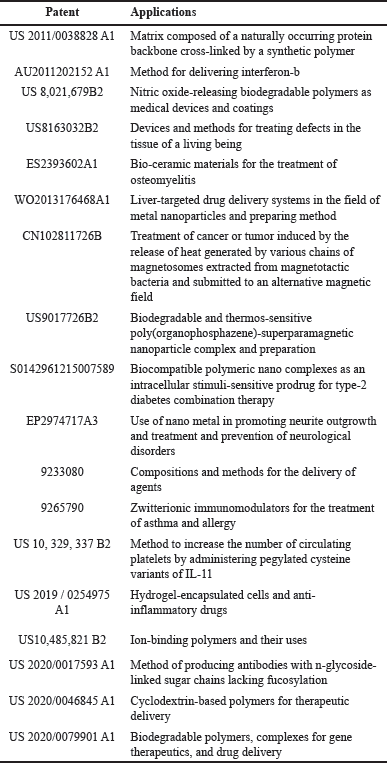 | Table 2. Biomaterial patents for therapeutic applications. [Click here to view] |
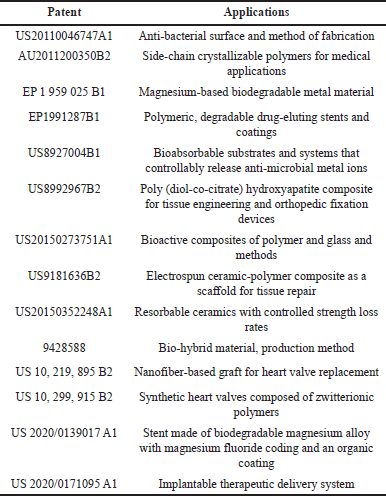 | Table 3. Biomaterial patents describing the application of stents, grafts, and implants. [Click here to view] |
Applications for medical devices
Various biomaterial combinations have been utilized substantially for the fabrication of medical devices like the hybrid unitary surgical device consisting of two groups of devices, one of which had a pair of biocompatible, bioresorbable anchors while the second had extracellular matrix material, serving as tissue regenerating material [61]. Another would be the porous medical device made of continuous bioabsorbable polymer matrix and bio-ceramic fibers cast and used as a primary structure in medical devices with osteochondral applications [62].
Metallic microneedles made of an electrically conductive polymer layer and metal layer are useful in the transdermal delivery of macromolecules [63]. In-vivo biodegradable medical implants are the recent focus. These implants made from fine-grained metallic materials are rigid, stiff, and lightweight and have various stent applications [64]. Biodegradable polyphosphazenes containing pyrrolidone side groups, as studies show, are useful as drug delivery carriers, plasma expanders, and biocompatible coatings for medical devices [65]. Another medical device generated from type-one and type-two polymer coatings is used with drug-eluting stents [66]. Radiopaque-shaped memory polymers are in demand in the fabrication of medical devices. These polymers are chosen because of their sufficient resistance to water absorption and their ability to deform temporarily, facilitating insertion into vessels, lumen, and aperture/cavity [67]. Poly (vinyl alcohol) (PVA)-bacterial cellulose (15% PVA with 0.5% bacterial cellulose) nanocomposite was the first material stiffed with a very high modulus and used for the creation of a broad range of medical devices [68]. Table 4 reviews biomaterial patents for medical device applications.
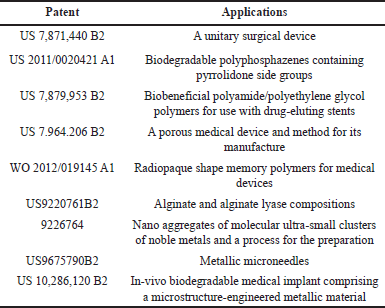 | Table 4. Biomaterial patents illustrating its application in medical devices. [Click here to view] |
Applications in tissue regeneration
After studying the applications of biomaterial patents in tissue re-growth/differentiation for a decade, it was shown that hybrid biomaterials are the most suitable for such use. That is to say, for example, a hybrid biological porous extracellular matrix scaffold prepared by suspension of extracellular matrix material in a liquid-forming slurry that coats a synthetic mat or through mixing or layering the slurry with a synthetic polymer solution was shown beneficial in repairing damaged or diseased tissue [69]. Another biomaterial utilized for in vivo tissue regeneration is the bioresorbable membrane, as it exhibits asymmetric osteoconductive behavior [70]. A composite made of bio-ceramics and degradable/nondegradable polymer was invented, displaying induction properties of repairing dentine [71] along with other biocompatible composites, including metal oxide and natural stem cells that hasten tissue and bone repair. The artificial component of the composite is porous and comprises ceria-stabilized zirconia, which provides a solid framework for cells to adhere to and regenerate the damaged tissue [72]. Biomatrix compositions constituting cross-linked lactoferrin, single or synergistic with organic or inorganic components, are considered applicable for musculoskeletal tissue regeneration [73]. Another evident example would be implanted from bio-resorbable materials blended with biocompatible ceramics and glass, which help regenerate selected tissues and, in turn, treat tissue-related defects [33]. However, there are no significant novel patents utilizing bio-metals or biopolymers alone for the tissue regeneration application. Figure 4 shows biomaterial application in tissue growth. Table 5 summarizes biomaterial patents for tissue regeneration.
Applications in wound healing process
From the patent analysis of the decade, it has been observed that bio-polymers have been used considerably for wound healing. For instance, a multicomponent dressing with super-absorbing polymers absorbs the wound secretions while staying attached to it until the dressing is removed. This is evident in promoting efficient wound treatment [74]. Additionally, hemoglobin-based polymeric oxygen carriers for artificial blood substitutes having di-block copolymers as main components display wound-healing applications [75]. Recent compositions having one or more elemental metals with nonconducting/semi-conducting materials as coatings hold pain-relieving and injury-healing characteristics [76]. Tissue engineering has emerged as a promising avenue for expediting wound healing, utilizing diverse biomaterials to facilitate the regeneration of damaged tissue. Notably, cerium oxide nanoparticles have garnered considerable interest owing to their diverse bioactivities. The integration of cerium oxide nanoparticles into polymer-based scaffolds tailored for wound healing has exhibited encouraging outcomes, accelerating the pace of the healing process [77,78]. Figure 5 shows the biomaterial application for the wound healing process. The biomaterial patents for wound healing applications are tabulated in Table 6.
 | Figure 4. Biomaterial patents illustrating the applications in tissue growth/repair. [Click here to view] |
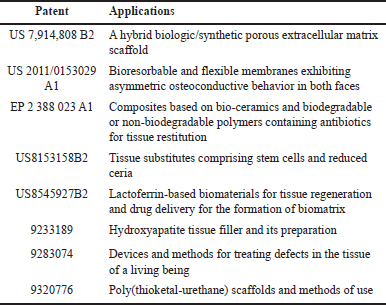 | Table 5. Biomaterial patents describing the applications for tissue regeneration. [Click here to view] |
Orthodontic applications
Along with all the previous applications whereby biomaterials proved effective, bio-ceramics have been used substantially for dental applications. That is due to the fact that medical and dental biomaterials made from calcium silicate, calcium oxide, and CaP compounds are biocompatible, anti-bacterial, and capable of forming an effective seal for the filled cavity of teeth by setting efficiently in the root canal [79]. However, composite bio-ceramics with good mechanical strength and bioactivity were observed for dental implants [80]. For dental restorations, CeO2-stabilized ZrO2 ceramics, which have been recently formulated, are used due to their excellent mechanical properties [81]. Furthermore, Benzalkonium chloride compositions (hybrid biomaterials) were found to reduce bond strength degradation between the resulting dental restoration and the underlying tissue [82]. An oral care composition made from a coordination complex of metal cation (preferably zinc) was found to be effective in suppressing the activity of microbes responsible for oral cavities [83]. Recently, cross-linked polymer formulations have been invented for adjustment and re-positioning of teeth [84]. Figure 6 shows the application of biomaterials in dental carriers. The biomaterial patents for dental applications are summarised in Table 7.
 | Figure 5. Biomaterial patents illustrating the applications in wound healing. [Click here to view] |
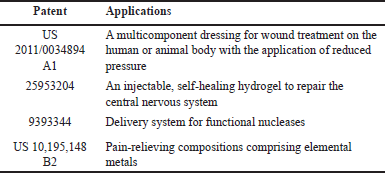 | Table 6. Biomaterial patents and their applications in injury healing. [Click here to view] |
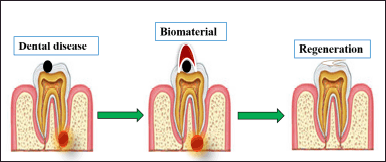 | Figure 6. Biomaterial patents illustrating the applications in dental caries. [Click here to view] |
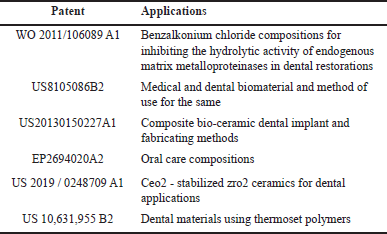 | Table 7. Biomaterial patents for dental applications. [Click here to view] |
Ophthalmic applications
Biomaterials have aided in the formulation of ocular lenses for retinal rectification. A dual-purpose pressed porous Si-PCL (polycaprolactone) composite implant exhibited enhanced ocular cell attachment and growth with its absorbable surface for drug loading [85]. Another improved implant made of a solid metal ring, a solid polymer shape, a mesh polymer shape, or a combination of both is used for the correction of myopia and hyperopia [86]. Furthermore, a recent invention useful for treating corneal defects is the Inter alia, a novel biocompatible, easy-to-handle, light-cross linkable, and bio-adhesive that integrates between the collagen matrix of the cornea and sclera [87]. Corneal transplantation remains the predominant form of transplant globally, serving to ameliorate visual impairment resulting from severe corneal damage. However, transplantation has inherent risks, including immune-mediated responses leading to rejection and the potential transmission of diseases from the donor tissue. Furthermore, the process of organ or tissue transplantation encounters multifaceted cultural, ethical, and legal challenges. Keratoprosthesis, such as Boston KPro and osteo-odonto-keratoprosthesis, offers a surgical alternative to traditional donor transplantation, albeit with varying success rates. While materials and designs of keratoprostheses differ, poly(methyl methacrylate) commonly serves as the primary material due to its stability and biocompatibility [88,89].
 | Table 8. Biomaterial patents for ophthalmic applications. [Click here to view] |
Other innovations include silicone hydrogel contact lenses with a well-constructed coating that possesses a water-gradient structural configuration with a soft and lubricious surface [90]. Bio-metals are also employed to produce contact lenses that obstruct the growth and adhesion of bacteria or other microbes on their surface [91]. An ophthalmic composition containing a synergistic combination of two polymers suitable enough for topical ophthalmic administration was invented recently [92]. Biomaterial patents for ophthalmic applications are tabulated in Table 8.
FUTURE TRENDS
Researchers are currently pursuing automated generation via computer-aided transfer processes (bioprinting) of structurally assembled and biologically working products from live cells, biomolecules, and biomaterials (mainly hydrogels and shape memory polymers, bioceramics, and biometals) with explicate 2D or 3D constructions (bio-fabrication). These biomaterials developed with the help of bioprinting techniques are known as Bioinks and can recreate complicated tissue properties like shape, vasculature, and specific functionalities, facilitating 4D printing of innumerable potentials and applications in the biomedical field [93]. Researchers are also working to design biomaterials that have the potential to mimic the dynamic and heterogeneous characteristics of the endemic extracellular matrix. Photoresponsive biomaterials are being exploited thoroughly due to their capabilities of site-specific therapeutic delivery in vivo and 4D modulation of synthetic cell culture platforms to mimic the complexity of the human body in vitro [94].
CONCLUSIONS
Biomaterials have been a key element in the fabrication of devices with humongous biomedical applications. The growing interest in biomaterials comes from patent analyses over the past decade. With the versatility of biomaterials, the interest in research for the manipulation of these materials and the number of inventions coming up every year has been on a significant rise. However, one of the drawbacks of these inventions, as seen in most patents, is the ambiguous explanations of the mode of action of the biomaterial for a particular application. Without a clear understanding of the mode of action of the material, it becomes difficult to compare, rank the products, or classify them as novel or an advancement of prior similar products.
The next generation of biomaterials is expected to be more accurate both structurally and functionally, with improved biocompatibility with the human body. With 3D and 4D printing technologies, we hope to see drastic innovations in tissue engineering and regenerative medicine. The “omics” technologies and artificial intelligence-based approaches can also be of great use when it comes to understanding and generating biomaterials applicable to regenerative medicine. With advanced technologies and biomaterials, it is promising to be able to achieve regeneration of the whole tissue/organ within the next decade. Bio-fabricated skin/cartilage/vascular/cardiac patches and peripheral neural grafts may be made available in the clinics in the next 5–10 years. Also, with the ability to detect, biomaterials are capable of treating or rectifying many diseases, including cancer. Photoresponsive biomaterials are currently limited to being applicable in transdermal patches, yet with a combination of optogenetics and photoresponsive biomaterials. It is possible to have control over 4D cell fate. The future awaits more innovative and exciting inventions of biomaterials that would drastically revolutionize the biomedical field.
ACKNOWLEDGMENTS
The authors would like to thank the biomaterials group of the Department of Biotechnology, Manipal Institute of Technology, Manipal, for providing facilities to carry out this work. Special thanks to Dr. Balaji S for his critical remarks on the manuscript.
AUTHOR CONTRIBUTIONS
All authors made substantial contributions to conception and design, acquisition of data, or analysis and interpretation of data; took part in drafting the article or revising it critically for important intellectual content; agreed to submit to the current journal; gave final approval of the version to be published; and agree to be accountable for all aspects of the work. All the authors are eligible to be an author as per the International Committee of Medical Journal Editors (ICMJE) requirements/guidelines.
FINANCIAL SUPPORT
There is no funding to report.
CONFLICTS OF INTEREST
The authors report no financial or any other conflicts of interest in this work.
ETHICAL APPROVALS
This study does not involve experiments on animals or human subjects.
DATA AVAILABILITY
All data generated and analyzed are included in this research article.
PUBLISHER’S NOTE
This journal remains neutral with regard to jurisdictional claims in published institutional affiliation.
REFERENCES
1. Cao D and Ding J. Recent advances in regenerative biomaterials. Regen Biomater 2022;9:rbac098. CrossRef
2. Dzobo K, Thomford NE, Senthebane DA, Shipanga H, Rowe A, Dandara C, et al. Advances in regenerative medicine and tissue engineering: innovation and transformation of medicine. Stem Cells Int 2018;2018:2495848. CrossRef
3. Trucillo P. Biomaterials for drug delivery and human applications. Mater. 2024;17:456. CrossRef
4. Ratner BD. Biomaterials: been there, done that, and evolving into the future. Annu Rev Biomed Eng. 2019;21:171–91. https://doi.org/101146/annurev-bioeng-062117-120940 5.Pesode P, Barve S, Wankhede SV, and Ahmad A. Sustainable materials and technologies for biomedical applications. Adv Mater Sci Eng. 2023;2023:1–22. CrossRef
6. John ?. Selected developments and medical applications of organic–inorganic hybrid biomaterials based on functionalized spherosilicates. Mater Sci Eng C. 2018;88:172–81. CrossRef
7. Jaganathan SK, Supriyanto E, Murugesan S, Balaji A, and Asokan MK. Biomaterials in cardiovascular research: applications and clinical implications. Biomed Res Int. 2014;2014:459465. CrossRef
8. Al-Shalawi FD, Mohamed Ariff AH, Jung DW, Mohd Ariffin MKA, Seng Kim CL, Brabazon D, et al. Biomaterials as implants in the orthopedic field for regenerative medicine: metal versus synthetic polymers. Polym. 2023;15:2601. CrossRef
9. Lam MT and Wu JC. Biomaterial applications in cardiovascular tissue repair and regeneration. Expert Rev Cardiovasc Ther. 2012;10:1039. CrossRef
10. Bhat S and Kumar A. Biomaterials and bioengineering tomorrow’s healthcare. Biomatter 2013;3:e24717. CrossRef
11. Spoial? A, Ilie CI, Ficai D, and Ficai A. Biomaterials. In: Gunduz O, Egles C, Pérez RA, Ficai D, Ustundag CB, editors. Biomaterials and tissue engineering. Stem Cell Biol Regen Med. Cham, Switzerland: Springer; 2023. vol. 74, pp 97–129. CrossRef
12. Datta LP, Manchineella S, and Govindaraju T. Biomolecules-derived biomaterials. Biomaterials 2020;230:119633. CrossRef
13. Marin E. History of dental biomaterials: biocompatibility, durability and still open challenges. Herit Sci 2023;11:1–25. CrossRef
14. Koons GL, Diba M, and Mikos AG. Materials design for bone-tissue engineering. Nat Rev Mater 2020;5:584–603. CrossRef
15. Beri P, Matte BF, Fattet L, Kim D, Yang J, and Engler AJ. Biomaterials to model and measure epithelial cancers. Nat Rev Mater. 2018;3:418–30. CrossRef
16. Li C, Guo C, Fitzpatrick V, Ibrahim A, Zwierstra MJ, Hanna P, et al. Design of biodegradable, implantable devices towards clinical translation. Nat Rev Mater. 2019;5:61–81. CrossRef
17. Sadtler K, Singh A, Wolf MT, Wang X, Pardoll DM, and Elisseeff JH. Design, clinical translation and immunological response of biomaterials in regenerative medicine. Nat Rev Mater. 2016;1:1–17. CrossRef
18. Mitrousis N, Fokina A, and Shoichet MS. Biomaterials for cell transplantation. Nat Rev Mater. 2018;3:441–56. CrossRef
19. CN103055352A—Calcium phosphate/collagen composite bioceramic material and preparation method- Google Patents. 2023 [cited 2023 Dec 20]. Available from: https://patents.google.com/patent/CN103055352A
20. CN102488927B—Bone repair materials and methods of preparation- Google Patents. Available from: https://patents.google.com/patent/CN102488927B 2023 [cited 2023 Dec 20].
21. US8574611B2—Composite bone repair material—Google Patents. 2023 [cited 2023 Dec 20]. Available from: https://patents.google.com/patent/US8574611B2
22. CN103432624A—Injectionable liquid metal bone cement, preparation method and special injection device—Google Patents. 2023 [cited 2023 Dec 20]. Available from: https://patents.google.com/patent/CN103432624A
23. JP2014221427A—Bone formation device for the repair of bone and its use—Google Patents. 2023 [cited 2023 Dec 20]. Available from: https://patents.google.com/patent/JP2014221427A/en
24. Xi Z, Tan C, Xu L, Yang N, and Li Q. Preparation of novel functional Mg/O/PCL/ZnO composite biomaterials and their corrosion resistance. Appl Surf Sci. 2015;351:410–5. CrossRef
25. US20150141333A1—Keratin bioceramic compositions - Google Patents. [cited 2023 Dec 20]. 2023 Available from: https://patents.google.com/patent/US20150141333A1/en?oq=US+2015%2F0141333+A1
26. US10610270B2—Hybrid intramedullary rods—Google Patents. 2023 [cited 2023 Dec 20]. Available from: https://patents.google.com/patent/US10610270B2
27. EP2249718B1—Apparatus for fracture repair—Google Patents. [cited 2023 Dec 20]. Available from: https://patents.google.com/patent/EP2249718B1
28. JP2011219359A—Method for producing ceramic porous materials—Google Patents. [cited 2023 Dec 20]. Available from: https://patents.google.com/patent/JP2011219359A
29. JP2011229518A—Method for producing cartoon meat using artificial bones—Google Patents. [cited 2023 Dec 20]. Available from: https://patents.google.com/patent/JP2011229518A
30. CN103251983A—A method for preparing slicing artificial bone filling sustained-release materials with therapeutic effects—Google Patents. [cited 2023 Dec 20]. Available from: https://patents.google.com/patent/CN103251983A
31. US9566156B2—Composite device that combines porous metal and bone stimuli—Google Patents. [cited 2023 Dec 20]. Available from: https://patents.google.com/patent/US9566156B2/en?oq=US9%2C566%2C156B2
32. US2011A—Appabatxts for piling saws—Google Patents. [cited 2023 Dec 20]. https://patents.google.com/patent/US2011
33. US8163032B2—Devices and methods for treating defects in the tissue of a living being—Google Patents. [cited 2023 Dec 20]. Available from: https://patents.google.com/patent/US8163032B2
34. WO2013176468A1—Liver targeted drug delivery systems using metal nanoparticles and preparing method—Google Patents. [cited 2023 Dec 20]. Available from: https://patents.google.com/patent/WO2013176468A1
35. US9017726B2—Biodegradable and thermosensitive poly(organophosphazene)-superparamagnetic nanoparticle complex, preparation method and uses—Google Patents. [cited 2023 Dec 20]. Available from: https://patents.google.com/patent/US9017726B2
36. US10329337B2—Method to increase the number of circulating platelets by administering PEGylated cysteine variants of IL-11—Google Patents. [cited 2023 Dec 20]. Available from: https://patents.google.com/patent/US10329337B2/en?oq=US10%2C329%2C337B2
37. US2019A—goedes—Google Patents. [cited 2023 Dec 20]. Available from: https://patents.google.com/patent/US2019
38. US2020A—Mode of regulating the pressure of steam—Google Patents. [cited 2023 Dec 20]. Available from: https://patents.google.com/patent/US2020
39. AU2011202152A1—Method for Delivering Interferon-B—Google Patents. [cited 2023 Dec 20]. Available from: https://patents.google.com/patent/AU2011202152A1
40. CN102811726B—Treatment of cancer or tumor induced by the release of heat generated by various chains of magnetosomes extracted from magnetotactic bacteria and submitted to an alternative magnetic field—Google Patents. [cited 2023 Dec 20]. Available from: https://patents.google.com/patent/CN102811726B/en
41. EP2974717A3—Use of nano metal in promoting neurite outgrowth and treatment and/or prevention of neurological disorders—Google Patents. [cited 2023 Dec 20]. Available from: https://patents.google.com/patent/EP2974717A3
42. US8021679B2—Nitric oxide-releasing biodegradable polymers useful as medical devices and coatings therefore - Google Patents. [cited 2023 Dec 20]. Available from: https://patents.google.com/patent/US8021679B2/en?oq=US+8%2C021%2C679B2
43. Wang FZ, Xie ZS, Xing L, Zhang BF, Zhang JL, Cui PF, et al. Biocompatible polymeric nanocomplexes as an intracellular stimuli-sensitive prodrug for type-2 diabetes combination therapy. Biomaterials. 2015;73:149–59. CrossRef
44. US10485821B2—Ion binding polymers and uses—Google Patents. [cited 2023 Dec 20]. Available from: https://patents.google.com/patent/US10485821B2/en?oq=US10%2C485%2C821B2
45. US20200046845A1—Cyclodextrin-based polymers for therapeutic delivery—Google Patents. [cited 2023 Dec 20]. Available from: https://patents.google.com/patent/US20200046845A1/en?oq=US2020%2F0046845A1
46. US20200079901A1—Biodegradable polymers, complexes for gene therapeutics and drug delivery, and methods related thereto—Google Patents. [cited 2023 Dec 20]. Available from: https://patents.google.com/patent/US20200079901A1/en?oq=US2020%2F0079901A1
47. US20110046747A1—Anti-bacterial surface and method of fabrication—Google Patents. [cited 2023 Dec 20]. Available from: https://patents.google.com/patent/US20110046747A1/en?oq=US20110046747A1
48. US20150273751A1—Bioactive composites of polymer and glass and method for making same—Google Patents. [cited 2023 Dec 20]. Available from: https://patents.google.com/patent/US20150273751A1/en?oq=US20150273751A1
49. US9181636B2—Electrospun ceramic-polymer composite as a scaffold for tissue repair—Google Patents. [cited 2023 Dec 20]. Available from: https://patents.google.com/patent/US9181636B2/en?oq=US9181636B2
50. US10219895B2—Nanofiber-based graft for heart valve replacement and methods of using the same—Google Patents. [cited 2023 Dec 21]. Available from: https://patents.google.com/patent/US10219895B2/en?oq=US10%2C219%2C895B2
51. US20200171095A1—Implantable therapeutic delivery system and methods—Google Patents. [cited 2023 Dec 21]. Available from: https://patents.google.com/patent/US20200171095A1/en?oq=US2020%2F0171095A1
52. US20150352248A1—Resorbable ceramics with controlled strength loss rates—Google Patents. [cited 2023 Dec 21]. Available from: https://patents.google.com/patent/US20150352248A1/en?oq=US20150352248A1
53. EP1959025B1—Magnesium-based biodegradable metal material—Google Patents. [cited 2023 Dec 21]. Available from: https://patents.google.com/patent/EP1959025B1/en?oq=EP1959025B1
54. US8927004B1—Bioabsorbable substrates and systems that controllably release anti-microbial metal ions—Google Patents. [cited 2023 Dec 21]. Available from: https://patents.google.com/patent/US8927004B1/en?oq=US8927004B1
55. EP3342433A1—Stent made of a biodegradable magnesium alloy with a magnesium fluoride coding and an organic coating—Google Patents. [cited 2023 Dec 21]. Available from: https://patents.google.com/patent/EP3342433A1/en?oq=EP3342433A1
56. US20200139017A1—Stent made of a bio-degradable magnesium alloy with a magnesium fluoride coating and an organic coating—Google Patents. [cited 2023 Dec 21]. Available from: https://patents.google.com/patent/US20200139017A1/en?oq=US2020%2F0139017A1
57. AU2011200350B2—Side-chain crystallizable polymers for medical applications—Google Patents. [cited 2023 Dec 21]. Available from: https://patents.google.com/patent/AU2011200350B2/en?oq=AU2011200350B2
58. EP1991287B1—Polymeric, degradable drug-eluting stents and coatings—Google Patents. [cited 2023 Dec 20]. Available from: https://patents.google.com/patent/EP1991287B1/en?oq=EP1991287B1
59. US8992967B2—Poly (diol-co-citrate) hydroxyapatite composite for tissue engineering and orthopaedic fixation devices—Google Patents. [cited 2023 Dec 21]. Available from: https://patents.google.com/patent/US8992967B2/en?oq=US8992967B2
60. US10299915B2—Synthetic heart valves composed of zwitterionic polymers—Google Patents. [cited 2023 Dec 21]. Available from: https://patents.google.com/patent/US10299915B2/en?oq=US10%2C299%2C915B2
61. US7871440B2—Unitary surgical device and method—Google Patents. [cited 2023 Dec 21]. Available from: https://patents.google.com/patent/US7871440B2/en?oq=US7%2C871%2C440B2
62. US7964206B2—Porous medical device and method for its manufacture—Google Patents. [cited 2023 Dec 21]. Available from: https://patents.google.com/patent/US7964206B2/en?oq=US7.964.206B2
63. US9675790B2—Metallic microneedles—Google Patents. [cited 2023 Dec 21]. Available from: https://patents.google.com/patent/US9675790B2/en?oq=US9675790B2
64. US10286120B2—In-vivo biodegradable medical implant comprising a microstructure engineered metallic material—Google Patents. [cited 2023 Dec 21]. Available from: https://patents.google.com/patent/US10286120B2/en?oq=US10%2C286%2C120B2
65. US20110020421A1—Biodegradable polyphosphazenes containing pyrrolidone side groups—Google Patents. [cited 2023 Dec 21]. Available from: https://patents.google.com/patent/US20110020421A1/en?oq=US2011%2F0020421A1
66. US7879953B2—Biobeneficial polyamide/polyethylene glycol polymers for use with drug eluting stents—Google Patents. [cited 2023 Dec 21]. Available from: https://patents.google.com/patent/US7879953B2/en?oq=US7%2C879%2C953B2
67. WO2012019145A1—Radiopaque shape memory polymers for medical devices—Google Patents. [cited 2023 Dec 21]. Available from: https://patents.google.com/patent/WO2012019145A1/en?oq=WO2012%2F019145A1
68. US9220761B2—Alginate and alginate lyase compositions and methods of use—Google Patents. [cited 2023 Dec 21]. Available from: https://patents.google.com/patent/US9220761B2/en?oq=US9220761B2
69. US7914808B2—Hybrid biologic/synthetic porous extracellular matrix scaffolds—Google Patents. [cited 2023 Dec 21]. Available from: https://patents.google.com/patent/US7914808B2/en?oq=US7%2C914%2C808B2
70. US20110153029A1—Bioresorbable and flexible membranes exhibiting asymmetric osteoconductive behavior in both faces—Google Patents. [cited 2023 Dec 21]. Available from: https://patents.google.com/patent/US20110153029A1/en?oq=US2011%2F0153029A1
71. EP2388023A1—Composites on a basis of bioceramics and biodegradable or non biodegradable polymers, containing antibiotics for tissue restitution and products therefrom—Google Patents. [cited 2023 Dec 21]. Available from: https://patents.google.com/patent/EP2388023A1/en?oq=EP2388023A172.US8153158B2—Tissue substitutes comprising stem cells and reduced ceria—Google Patents. [cited 2023 Dec 21]. Available from: https://patents.google.com/patent/US8153158B2/en?oq=US8153158B2
73. US8545927B2—Lactoferrin-based biomaterials for tissue regeneration and drug delivery—Google Patents. [cited 2023 Dec 21]. Available from: https://patents.google.com/patent/US8545927B2/en?oq=US8545927B2
74. US20110034894A1—Multi-component dressing for wound treatment on the human or animal body with application of reduced pressure—Google Patents. [cited 2023 Dec 21]. Available from: https://patents.google.com/patent/US20110034894A1/en?oq=US2011%2F0034894A1
75. Tseng TC, Tao L, Hsieh FY, Wei Y, Chiu IM, and Hsu SH. An injectable, self-healing hydrogel to repair the central nervous system. Adv Mater. 2015;27:3518–24. CrossRef
76. US10195148B2—Pain relieving compositions comprising elemental metals—Google Patents. [cited 2023 Dec 21]. Available from: https://patents.google.com/patent/US10195148B2/en?oq=US10%2C195%2C148B2
77. US20130195927A1—Cerium oxide nanoparticles and associated methods for promoting wound healing—Google Patents. [cited 2023 March 11]. Available from: https://patents.google.com/patent/US20130195927A1/en
78. Nosrati H, Heydari M, and Khodaei M. Cerium oxide nanoparticles: synthesis methods and applications in wound healing. Mater Today Bio. 2023;23:100823. CrossRef
79. US8105086B2—Medical and dental biomaterial and method of use for the same—Google Patents. [cited 2023 Dec 21]. Available from: https://patents.google.com/patent/US8105086B2/en?oq=US8105086B2
80. US20130150227A1—Composite bio-ceramic dental implant and fabricating method—Google Patents. [cited 2023 Dec 21]. Available from: https://patents.google.com/patent/US20130150227A1/en?oq=US20130150227A1
81. US20190248709A1—CeO2-Stabilized ZrO2 Ceramics For Dental Applications—Google Patents. [cited 2023 Dec 21]. Available from: https://patents.google.com/patent/US20190248709A1/en?oq=US2019%2F0248709A1
82. WO2011106089A1—Benzalkonium chloride compositions for inhibiting the hydrolytic activity of endogenous matrix metalloproteinases in dental restorations—Google Patents. [cited 2023 Dec 21]. Available from: https://patents.google.com/patent/WO2011106089A1/en?oq=WO2011%2F106089A1
83. EP2694020A2—Oral care compositions—Google Patents. [cited 2023 Dec 21]. Available from: https://patents.google.com/patent/EP2694020A2/en?oq=EP2694020A2
84. US10631955B2—Dental materials using thermoset polymers—Google Patents. [cited 2023 Dec 21]. Available from: https://patents.google.com/patent/US10631955B2/en?oq=US10%2C631%2C955B2
85. Irani YD, Tian Y, Wang M, Klebe S, McInnes SJ, Voelcker NH, et al. A novel pressed porous silicon-polycaprolactone composite as a dual-purpose implant for the delivery of cells and drugs to the eye. Exp Eye Res. 2015;139:123–31. CrossRef
86. US9532902B2—Minimally-invasive method and apparatus for restructuring the retina—Google Patents. [cited 2023 Dec 21]. Available from: https://patents.google.com/patent/US9532902B2/en?oq=US9532902B2
87. WO2020051133A1—Light activated adhesive scaffold—Google Patents. [cited 2023 Dec 21]. Available from: https://patents.google.com/patent/WO2020051133A1/en?oq=WO2020051133A1
88. WO2009135068A1—Artificial cornea—Google Patents. [cited 2024 March 11]. Available from: https://patents.google.com/patent/WO2009135068A1/en
89. Nosrati H, Ashrafi Dehkordi K, Alizadeh Z, Sanami S, and Banitalebi-Dehkordi M. Biopolymer-based scaffolds for corneal stromal regeneration: a review. Polim Med. 2020;50:57–64. CrossRef
90. EP3291976B1—Method for producing contact lenses with durable lubricious coatings—Google Patents. [cited 2023 Dec 21]. Available from: https://patents.google.com/patent/EP3291976B1/en?oq=EP3291976B1
91. US20110111120A1—Preparation of anti-microbial contact lenses with reduced haze using swelling agents—Google Patents. [cited 2023 Dec 21]. Available from: https://patents.google.com/patent/US20110111120A1/en?oq=US2011%2F0111120A1
92. EP3028692B1—Ophthalmic compositions containing a synergistic combination of two polymers—Google Patents. [cited 2023 Dec 21]. Available from: https://patents.google.com/patent/EP3028692B1/en?oq=EP3028692B1
93. Moroni L, Burdick JA, Highley C, Lee SJ, Morimoto Y, Takeuchi S, et al. Biofabrication strategies for 3D in vitro models and regenerative medicine. Nat Rev Mater. 2018;3:21–37. CrossRef
94. Ruskowitz ER and Deforest CA. Photoresponsive biomaterials for targeted drug delivery and 4D cell culture. Nat Rev Mater. 2018;3:1–17. CrossRef